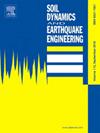Semi-analytical solution for calculating effective length of infinite axially loaded beam on two-parameter Pasternak foundation under a moving load
IF 4.6
2区 工程技术
Q1 ENGINEERING, GEOLOGICAL
引用次数: 0
Abstract
Using a finite beam with infinite boundary conditions to analogize the dynamic response of an infinite foundation beam under moving load is considered as a compromise approach in railway engineering applications. However, determining the optimal length of the finite beam to simulate the infinite beam has always been a pressing problem to be solved, especially for some complex infinite foundation beams. For this, this paper innovatively proposes a semi-analytical solution for calculating the effective length of infinite axially stressed two-parameter Pasternak foundation beams under moving loads. By assuming the displacement response of infinite foundation beams to be in exponential form, the formula for the effective length under different damping conditions is derived. The feasibility of the proposed theory is validated through the Fourier transform and residue theorem, and its accuracy is verified by comparing with existing methods. The parametric analysis shows that: (1) the derived closed-form solutions on different damping levels are highly accurate, and the proposed solution outperforms the residue theorem -based method as it eliminates the interference of imaginary numbers; (2) a supercritical-velocity moving load substantially extends the displacement - response transfer distance, greatly increasing the effective lengths of the front and back waves, while a subcritical - velocity load has a more modest effect; (3) foundation-related factors such as damping ratio, stiffness, and shear modulus, as well as axial loading, all have distinct impacts on the effective length. The study not only enriches the theoretical study of foundation beam effective lengths but also provides a more accurate and efficient calculation method, which has potential applications in high - speed railway engineering design and analysis.
移动荷载作用下双参数帕斯捷尔纳克基础无限轴向荷载梁有效长度的半解析解
采用具有无限边界条件的有限梁来模拟无限基础梁在移动荷载作用下的动力响应,是铁路工程应用中的一种折衷方法。然而,确定有限梁的最佳长度来模拟无限梁一直是一个迫切需要解决的问题,特别是对于一些复杂的无限基础梁。为此,本文创新性地提出了移动荷载作用下无限轴向应力双参数帕斯捷尔纳克基础梁有效长度的半解析解。假设无限基础梁的位移响应呈指数形式,推导了不同阻尼条件下有效长度的计算公式。通过傅里叶变换和剩余定理验证了该理论的可行性,并与现有方法进行了比较,验证了其准确性。参数分析表明:(1)推导出的不同阻尼水平下的闭型解精度高,且该解消除了虚数的干扰,优于基于残数定理的方法;(2)超临界速度移动载荷显著延长了位移响应传递距离,大大增加了前后波的有效长度,而亚临界速度移动载荷的影响则较为温和;(3)阻尼比、刚度、剪切模量等基础相关因素以及轴向荷载对有效长度的影响均明显。该研究不仅丰富了基础梁有效长度的理论研究,而且提供了一种更为准确、高效的计算方法,在高速铁路工程设计与分析中具有潜在的应用价值。
本文章由计算机程序翻译,如有差异,请以英文原文为准。
求助全文
约1分钟内获得全文
求助全文
来源期刊

Soil Dynamics and Earthquake Engineering
工程技术-地球科学综合
CiteScore
7.50
自引率
15.00%
发文量
446
审稿时长
8 months
期刊介绍:
The journal aims to encourage and enhance the role of mechanics and other disciplines as they relate to earthquake engineering by providing opportunities for the publication of the work of applied mathematicians, engineers and other applied scientists involved in solving problems closely related to the field of earthquake engineering and geotechnical earthquake engineering.
Emphasis is placed on new concepts and techniques, but case histories will also be published if they enhance the presentation and understanding of new technical concepts.
 求助内容:
求助内容: 应助结果提醒方式:
应助结果提醒方式:


